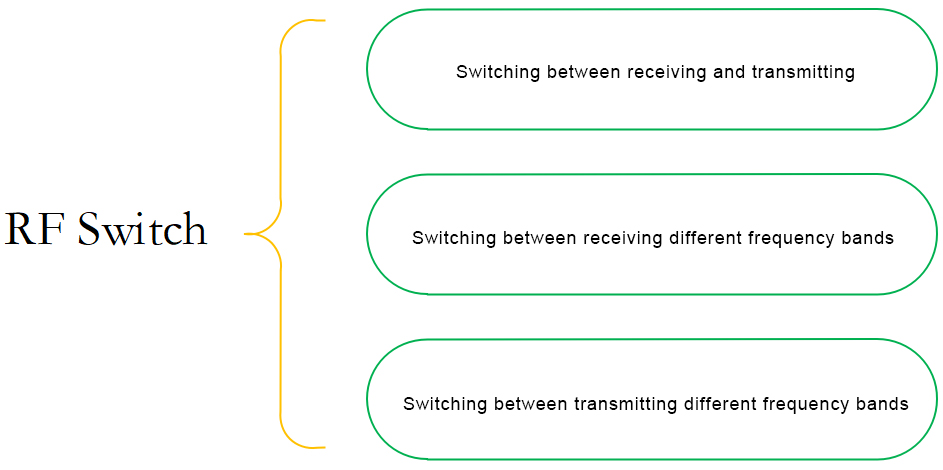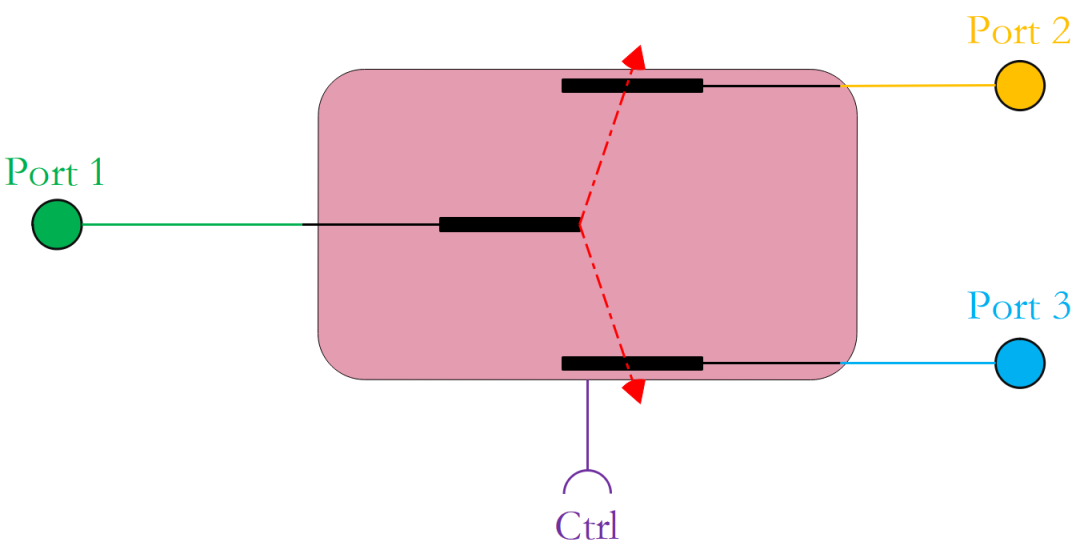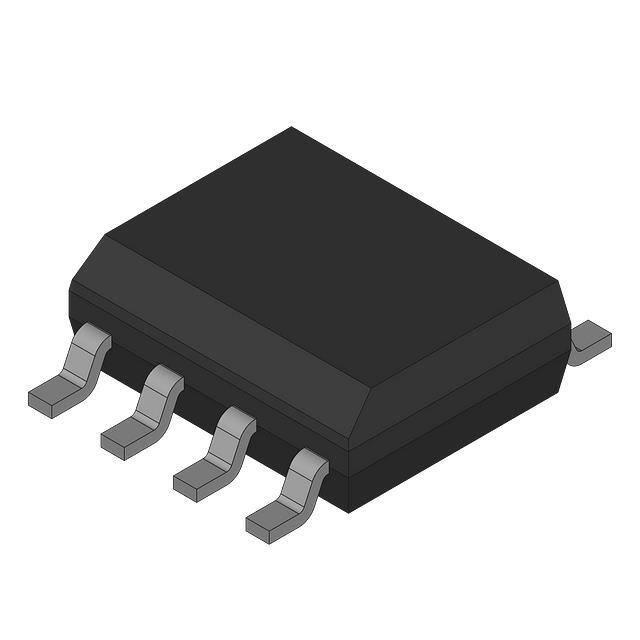What is an RF conductive switch
Discrete switches are also called RF conductive switches. Their function is to connect any one or several of the multiple RF signals through control logic to achieve switching of different signal paths, including switching between reception and transmission, switching between different frequency bands, etc. The switch product portfolio includes single-throw switches (SPST), single-pole multi-throw switches (SPNT) and multi-pole multi-throw switches (NPNT). These switch products use a variety of technologies, including SOI, pHEMT, GaN and PIN diodes, with excellent performance and wide application. The main types of RF conductive switch products include mobile communication conductive switches, Wi-Fi switches, etc., which use RF SOI materials and corresponding processes and are widely used in mobile smart terminals such as smartphones.

Figure 1: RF Switch Classification by Path
Principle and Structure
The working principle of the RF switch is shown in Figure 6-2: When different voltages are applied to the control port of the RF switch, the ports of the RF switch will show different connectivity. Taking a single-pole double-throw RF switch as an example, when a positive voltage is applied to the control port, the circuit connecting port 1 and port 3 is turned on, and the circuit connecting port 1 and port 2 is disconnected; when a zero voltage is applied to the control port, the circuit connecting port 1 and port 3 is disconnected, and the circuit connecting port 1 and port 2 is turned on.

Figure 2: The most basic single-pole double-throw switch
Absorption and reflection
Absorption RF switch: When the switch is in the on state, the signal can pass smoothly, and when the switch is in the off state, it absorbs the input signal and almost no reflection occurs. It is usually implemented using devices such as PIN diodes or field effect transistors (FETs). By controlling the bias voltage of these devices to switch between the on and off states, the RF signal can be controlled.
Reflection RF switch: Made based on micro-electromechanical system (MEMS) technology or ferrite materials, when the switch is on, the signal passes; when the switch is off, the signal is reflected back to the source. The reflective switch uses the reflection principle in the microwave transmission line. By changing the characteristic impedance of the transmission line, the signal is fully reflected in the cut-off state.
The absorption RF switch has the following characteristics:
Low insertion loss: In the on state, the absorption switch has little attenuation on the signal and can effectively transmit the RF signal. Usually, the insertion loss can be less than 1dB or even lower.
High isolation: In the cut-off state, it can absorb the input signal well, and the interference to other channels or circuits is small. The isolation can reach more than 30dB.
Good broadband performance: It can maintain good performance in a wide frequency range and is suitable for multi-band systems.
High linearity: It has a good linear response to the amplitude and phase of the input signal and is not easy to produce distortion.
The reflective RF switch has the following characteristics:
Fast switching speed: Based on technologies such as MEMS or ferrite, the switching speed of the reflective switch is usually faster than that of the absorption switch, which can meet the needs of high-speed signal switching. The switching time can reach nanoseconds or even faster.
Large power capacity, able to withstand high power signals, suitable for high-power RF systems, the power capacity of some reflective switches can reach tens of watts or even higher.
Small size: Using technologies such as micro-electromechanical systems, reflective switches can achieve smaller sizes, which is conducive to the miniaturization and integration of the system.
Application scenarios
Absorptive RF switch
1.Wireless communication system, in 2G, 3G, 4G, 5G and other base stations, used to switch RF signals between different frequency bands and different transceiver channels, such as F2932NBGP8 can be applied to base station 2G, 3G, 4G systems. The RF front-end module in the mobile phone needs an absorptive RF switch to switch signals of different frequency bands to achieve multi-mode and multi-frequency communication, ensuring the normal communication of the mobile phone in different network environments.
2.Test and measurement equipment, spectrum analyzer: In the spectrum analyzer, the absorptive RF switch can be used to switch different input signal sources or measurement channels, which is convenient for analyzing and measuring signals of different frequency bands. Network analyzer, used to quickly switch different test ports or frequency bands during the test process to improve test efficiency and accuracy.
3.Radar system. In the radar receiver, the absorptive RF switch can be used to switch different receiving channels to improve the radar's anti-interference ability and signal processing ability. Phased array radar: Each array element in the phased array radar needs to be connected to the transmit/receive channel through an RF switch. The absorptive RF switch can provide low insertion loss and high isolation to ensure the performance of the radar system.
Reflective RF switch
1.Satellite communication. The satellite transponder needs to use a reflective RF switch to realize signal switching between different frequency bands and different beams. Its fast switching speed and high power capacity can meet the requirements of satellite communication. Ground station: The RF equipment in the ground station also uses a reflective RF switch to switch different satellite communication links or frequency bands.
2.Radar system, transmitter: In the radar transmitter, the reflective RF switch is used to control the transmission path of the RF signal to realize beam scanning and switching. For example, some pulse radars need to quickly switch the transmission beam. Electronic warfare radar: Electronic warfare radar needs to have the ability to quickly interfere with enemy radar signals. The reflective RF switch can quickly switch the transmission of interference signals to interfere with and deceive enemy radars.
3.High-speed data transmission system, fiber-optic communication: In the RF front end of the fiber-optic communication system, the reflective RF switch can be used to switch different optical signal modulation modes or frequency bands to improve the data transmission rate and system capacity.
Performance indicators
1. Operating frequency range, which determines the RF frequency range that the discrete switch can be used for. Different application scenarios require switches with different frequency ranges.
2. Insertion loss, which refers to the power loss generated when the signal passes through the switch. The smaller the insertion loss, the smaller the impact of the switch on the signal.
3. Isolation, which measures the switch's ability to isolate the signal in the cut-off state. The higher the isolation, the better the isolation effect of the switch on different signal paths.
4. Power capacity, which indicates the maximum RF power that the switch can withstand. In high-power application scenarios, it is necessary to select a discrete switch with a larger power capacity. Products based on gallium nitride have the highest power handling capabilities.
5. Switching speed, which refers to the time required for the switch to switch from one state to another. For applications such as high-speed data transmission and real-time signal processing, the switch needs to have a faster switching speed.
Selection points
1. Determine the working frequency band. First, determine the working frequency range of the system where the RF switch is located. For example, in the 5G communication system, it is necessary to support the Sub-6GHz band and the millimeter wave band.
2. Frequency characteristic matching. Different types of RF switches have different performance at different frequencies. Absorption RF switches usually have better performance in low frequency bands, while reflection RF switches may have more advantages in high frequency bands, especially millimeter wave bands.
3. Evaluate the system power and understand the power of the RF signal in the system. For example, in high-power radar systems, the transmission power may be as high as several kilowatts, while in some low-power wireless sensor networks, the power is relatively low. Choose the appropriate power level: Absorption RF switches are generally suitable for medium and low power systems, and the power capacity is usually between a few watts and tens of watts; reflection RF switches are more suitable for high-power systems, and the power capacity can reach tens of watts or even higher.
4. Determine the switching speed requirements. According to the specific application scenarios of the system, clarify the requirements for the switching speed of the RF switch. For example, in high-speed data transmission systems, different signal paths need to be switched quickly, and the switching speed requirements are high; while in some slow monitoring systems, the switching speed requirements are relatively low. Comparison of switching speed indicators: The switching speed of absorptive RF switches is generally in the microsecond to millisecond level, while the switching speed of reflective RF switches can reach nanoseconds or even faster, which can meet the needs of high-speed signal switching.
5. Analyze the system's requirements for isolation. If the system has high requirements for signal isolation between different channels, such as in a multiple-input multiple-output (MIMO) communication system, interference between channels needs to be avoided, then a RF switch with high isolation should be selected. Considering the impact of insertion loss, insertion loss will cause signal power attenuation. For systems with high requirements for signal transmission quality, such as satellite communication systems, RF switches with low insertion loss should be selected to ensure effective signal transmission.
6. Size and integration Considering the system space limitations, in some miniaturized devices, such as smartphones and wearable devices, the size requirements for RF switches are high, and small and highly integrated products need to be selected. Reflective RF switches are based on technologies such as micro-electromechanical systems, and have the advantages of small size and easy integration with other circuits. They are more suitable for use in systems with high integration requirements.
7. Cost. Clearly define the cost limit of RF switches. The prices of RF switches of different types and performances vary greatly. Generally speaking, the prices of high-performance RF switches such as high-power, high-isolation, and high-switching speed products are relatively high. It is necessary to weigh them according to actual needs and choose cost-effective products on the premise of meeting system requirements.
Development trend
Absorption RF switch: With the continuous development of wireless communication technology, the performance requirements of absorptive RF switches are getting higher and higher. The future development trends mainly include further reducing insertion loss, improving isolation and linearity, and achieving higher integration and smaller size. At the same time, in order to meet the needs of 5G and future communication systems, absorptive RF switches also need to have a wider frequency band and faster switching speed.
Reflective RF switch: Reflective RF switch has unique advantages in high-frequency, high-speed and high-power applications. In the future, it will develop towards higher operating frequencies, greater power capacity and faster switching speeds. In terms of technology, it will continue to explore new micro-nano processing technologies and materials to improve the performance and reliability of switches.


